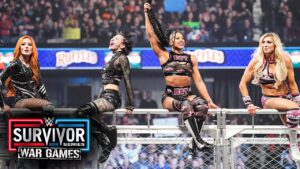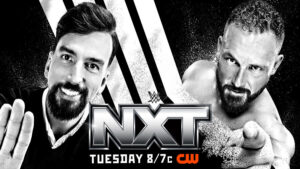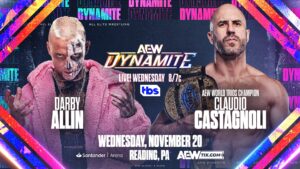Indie Watch is our regular series that looks at all of the amazing talents working the independent circuits around the world. Some are veterans revitalizing their careers, some are indie prospects hitting their peaks, while others are names to be on the watch for! In this edition, we take a look at Michigan’s “Amazing” N8 Mattson, a 24-year veteran of several eras of independent wrestling.
If you’ve gone through the Midwest as an indie wrestler in the past three decades – particularly in Michigan – there’s a good chance you’ve run into Detroit’s “Amazing” N8 Mattson. N8 Mattson debuted in 1996, a trainee at the newly opened Can-Am Wrestling School in Windsor, Ontario, Canada (Scott D’Amore‘s school that still runs today), and has competed in the US indies ever since – a remarkable career that has now spanned over four decades. Remarkably, N8 Mattson has been a sponge who has also witnessed, studied, and now teaches (at the same Can-Am school he started with as a student 25 years ago) multiple eras of professional wrestling – he was trained by veterans from the 1970s and witnessed the birth of the modern US indies in the late 1990s, and continues to compete in the current climate as well.
Throughout his career, N8 Mattson made appearances for companies like WWE, Ring of Honor, and TNA/IMPACT Wrestling, to hundreds of US indie promotions scattered throughout the country. N8 Mattson formed tag teams with the likes of Jimmy Jacobs and Truth Martini and has fought the likes of AJ Styles, Tyler Black (WWE’s Seth Rollins), Chris Sabin, Nigel McGuinness, Alex Shelley, Colt Cabana, “Spyder” Nate Webb, Roderick Strong, Monty Brown, Elix Skipper, Matt Cross, Lince Dorado, WARHORSE, Danhausen, Atticus Cogar, Nolan Edwards, and many, many more (you get the picture), at early stages of both his own career or theirs. N8 Mattson been an opponent and a friend, a mentor, and a student, to so many stars for many years. Last Word on Pro Wrestling recently talked to N8 Mattson to discuss his lengthy tenure in the industry, about his own inspirations and aspirations, what he’s learned from his teachers, and how he gives back to his students.
Last Word on Pro Wrestling: I know it’s cliche to ask, but I find everyone has different beginnings. As a young boy in Michigan, who was it that first caught your attention in pro wrestling that made you a fan? And who were the ones that ultimately put in your head “I want to do this”?
Nate / N8 Mattson: I became a fan right around WrestleMania III [in 1987]. I was ten years old and there was a ton of buzz in the local newspapers about that enormous event. Ultimately it was Randy “Macho Man” Savage, as he was billed back then, who totally mesmerized me as a kid. After some of those early Saturday Night’s Main Event specials featuring The Mega Powers, I was completely hooked. I read every wrestling magazine that was on the newsstand. When I was in High School, I discovered independent wrestling and watched guys like Al Snow, D’Lo Brown, Edge (Sexton Hardcastle), Johnny Swinger, Scott D’Amore, JT Lightning, and “Irish” Mickey Doyle and that’s when I decided to pursue it when I graduated.
You were mentored early by “Irish” Mickey Doyle. How did you come to find out about Mickey and get hooked up with him?
I was a big fan of Mickey before I met him. He was THE vet on the indie circuit then. I had sent away for an application to Al Snow‘s school, Body Slammers Gym. As fate would have it though, my boss at the K-Mart where I worked used to be a local wrestling promoter. He kayfabed this from me for a while because he knew I wanted to enter the business, but he kept trying to discourage me to see how bad I wanted it. After a while, he finally showed me pictures in his office of all the wrestlers he knew and he decided to help me.
My boss put me in contact with a guy named “Iron” Mike Anthony who charged me $300 for Mickey’s phone number. I assumed that money was going towards my training but actually only went in Anthony’s pocket, which I didn’t find out until I thought I was almost paid up, but that’s another story altogether. I wasn’t mad about it because after I called Mickey we became fast friends and he invited me to Can-Am and told me to bring my knee pads. That’s just the way the business was back then and I wouldn’t change a thing.
You were one of the first students at the Can-Am Dojo. What was training like in the early days of the school?
Training at Can-Am was pretty intense. Lots of calisthenics, cardio drills, mat work, thousands of squats. My legs would burn for days after each practice. I was in awe just being in the ring and I picked it up pretty quick. Mickey and Scott were the first to break me in, then “Canadian Destroyer” Doug Chevalier started stretching me, haha. Regulars at that time who helped me a lot included Bobby Clancy, Otis Apollo, Mike Legacy, and Rhino. My stomach would be in knots coming across the border from my nerves but for a 19-year-old kid, I was in wrestling heaven.
What were some of the teachings you got early on that have remained true to this day in an industry that is always evolving?
All of the things I learned from Mickey, Scott, Doug, and other vets that never change is that you gotta stay humble. This is an ego-driven business, but there’s a time and place and you have to check your attitude. Respect those who came before you, and be a student of the business. Learn as many facets as you can to get an appreciation for every job description. We all need each other to be successful, no one can do it alone.
After spending the first few years in the Michigan indies, you started to break into the rising US indie scene in the early 2000s. What was the feeling like in this new revolution post demise of WCW and ECW?
I definitely started traveling more in the early 2000s, Cleveland, Nashville, Philly, Chigaco. Established talent that was off TV were now working with the up-n-comers and new stars were emerging on the indie circuit. There was no social media, only tape trading and word of mouth was how anyone heard of you. It felt very punk rock because these shows were gritty and the production was rudimentary at best. The NWA was still leading the charge on the indie level but that was about to change big time.
You kind of started wrestling as the landscape was changing in regards to the philosophy and style of indie wrestlers. How did people like Reckless Youth, AJ Styles, etc. change thinking of what could be done in the late 90s/early 2000s?
The hardcore aspect of ECW and WCW’s Cruiserweight division played a huge role in shaping the indie scene. Local guys were taking more and more risks hoping to get noticed by a scout or vet who could help them get a job. Reckless was a guy I saw live and he was one of the first guys to blend all the styles together on the indies. AJ is just in a league of his own. Those guys started to up the ante because fans demanded more for their money, and once word spread about the action-packed bouts they were having, houses started to go up.
In the early 2000s, you worked for rising new promotions like TNA (in 2003 and 2004) and ROH (2008, 2010, 2011) at events. What was the energy like in these new promotions in a world that was predominantly based around WWE?
Both TNA and ROH were unique because fans were now seeing a hybrid style on a regular basis, mixed with some established names. Indie talent now had two legitimate places to go to get national exposure and become breakout stars. The production values were better than average indie promotions and diehard fans liked that they had other options besides WWE. The times I worked for those companies, the fans were very passionate and you had to give them your all to impress them.
There has been plenty of criticism in recent years about the way many veterans approached training new wrestlers. What are some of the teachings that you feel ultimately were proven to be archaic and which ones do you think are still important to the lifeblood of the industry?
In the old days, the business was protected more because you didn’t want a quote/unquote “mark” in your locker room going home and giving away all the trade secrets to his friends and family. For the sake of the magic, some things need kayfabe for this to work. Before the business was totally exposed, prospects would get beaten up or stretched, but that rarely happens anymore. That doesn’t mean things don’t get extremely physical. You have to understand the difference between loose and tight, light or snug. You have to see what people are made of, and pushing them as far as you can. The weak get weeded out due to the rigorous nature, those who listen and endure usually find their way.
Throughout your career, you’ve worked with many talents that ultimately became legit global superstars. Who were some of the ones you worked with that you knew right away were destined for greatness?
I was blessed to be where I was in those days. Chris Sabin came along about four years after me. We hit it off right away. I actually brought him to Can-Am after I trained him at the NWA Michigan school. Sabin was born for this. Petey Williams is another guy, met him when he was learning how to dropkick. Even before adopting the Canadian Destroyer, Petey had that same passion and drive that Sabin had. I worked with AJ Styles before he won his first NWA Worlds Title. He just carried himself as a star, yet was still humble enough to go to church with me one Sunday morning. Before Zach Gowen had his TNA tryout, he was tearing up rings in Detroit. All these guys are still good pals and wonderful human beings.
On the other side, who were some talents that you thought would join those people in the top tier that ultimately didn’t? Why do you think they never got past a certain level?
The wrestling business isn’t always fair, and not everyone makes it. That’s how competitive it is; you need certain intangibles, connections, timing, and sometimes luck. Some guys received numerous opportunities while others maybe only got one shot and higher-ups may not have seen anything in them that day. I don’t want to name names, but there’s plenty of guys who have all the tools but just couldn’t get over with the office. You have to learn how to politick a little in order to succeed in this line of work.
You’re now a trainer yourself, with Can-Am. How has your experience helped you create your training methods and how have you managed to stay true to the history of the sport while helping its evolution going forward?
I am extremely honored to be one of the trainers at Can-Am. It is THE place to go if you are serious about learning the trade. I teach the old fashioned way, I’m hands-on and I stress mastering the basics. I won’t have students moving on to the next thing too soon until I see improvement on a weekly basis. If your lockups suck, we’re locking up until it looks good. Can-Am has a reputation of producing quality talent, and no one gets cleared until the trainers work with them individually in practice matches to feel out what needs improvement. People from all over the world attend Can-Am to polish up, and that says a lot about our pedigree and passion for teaching future stars.
John E. Bravo, IMPACT Star, Trainer at Can-Am: It’s been fun training the next generation of professional wrestlers with Nate Mattson at the Can-Am wrestling school, he had been absent from the school for years because he went out into the world to learn different styles from various different parts of the country but it’s nice to have him back, it feels like he belongs at Can-Am. I tell the students that are training to watch Nate Mattson, his mannerisms in the ring. Nate always knows a perfect way to interact with the crowd to get them to care.
What are some of the myths you see younger talents perpetuating that you wish they’d look past in order to take themselves to the next level?
I always tell guys that selling is your best friend. Some guys don’t like selling because they think it makes them look weak… That’s the point! Being vulnerable garners sympathy for a babyface, it’s how they get over and connect to fans emotionally. Heels sell to make their opponents. Like I said, we all need each other and certain things make the matches better for the fans. You can’t be selfish here, it’s a team effort. Also, don’t take shortcuts. There’s no quick surefire way to the top so don’t be so eager to steal a move or do something dangerous that you’re not proficient at yet. Give yourself time to learn, grow, make mistakes, and mature. Don’t rush things, enjoy the journey. If you’ve done your best, opportunities will come.
John E. Bravo: Being someone that trained in the 90s, Nate has adapted his style over the years to stay relevant, in today’s current wrestling climate, without losing too much of what makes him so versatile to begin with. Not everyone has chemistry in professional wrestling… The sign of a good wrestler is someone that has chemistry with anyone and can make anyone look good in a match, that certainly is hard to do, Nate is one of those guys. I can’t remember the last time I saw Nate have a bad match with anyone. To me, Nate Mattson is the ultimate babyface, even though he can play a great heel. He has always really known how to connect with a crowd and make them feel like they’re a part of his goal of trying to win.
Ultimately, what is the legacy you hope to leave behind for “Amazing” N8 Mattson?
I achieved more than I ever thought possible, it’s crazy to me. So many people took care of me, I owe them so much. I hope that people will see me as a talent that truly loved being in the ring, it really is my happy place. I hope I helped others take a few steps in the right direction concerning their careers. I am humbled when young guys ask me what I thought of their matches. I hope fans were entertained by my antics and left the show feeling they received a quality match. That to me would be amazing!
Check out our full list of previous Indie Watches, showcasing emerging talent from around the world!
Stay tuned to the Last Word on Pro Wrestling for more on this and other stories from around the world of wrestling, as they develop. You can always count on LWOPW to be on top of the major news in the wrestling world, as well as to provide you with analysis, previews, videos, interviews, and editorials on the wrestling world. Looking to talk wrestling, pro football, or any number of sports? Head on over to the LWOS Boards to engage in conversation with fellow fans!







